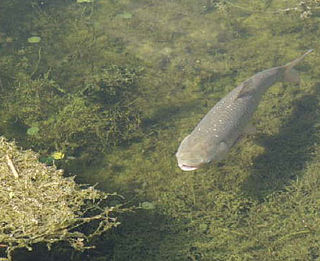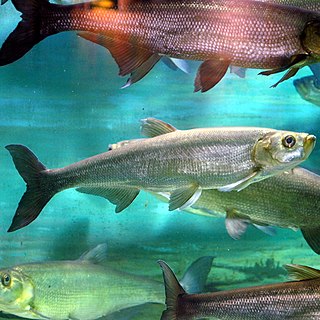
The term carp is a generic common name for numerous species of freshwater fish from the family Cyprinidae, a very large clade of ray-finned fish mostly native to Eurasia. While carp are prized quarries and are valued as both food and ornamental fish in many parts of the Old World, they are generally considered useless trash fish and invasive pests in many parts of Africa, Australia and most of the United States.

The Eurasian carp or European carp, widely known as the common carp, is a widespread freshwater fish of eutrophic waters in lakes and large rivers in Europe and Asia. The native wild populations are considered vulnerable to extinction by the International Union for Conservation of Nature (IUCN), but the species has also been domesticated and introduced into environments worldwide, and is often considered a destructive invasive species, being included in the list of the world's 100 worst invasive species. It gives its name to the carp family, Cyprinidae.

Cypriniformes is an order of ray-finned fish, including the carps, minnows, loaches, and relatives. Cypriniformes is an Order within the Superorder Ostariophysi consisting of "Carp-like" Ostariophysins. This order contains 11-12 families, although some authorities have designated as many as 23, over 400 genera, and more than 4,250 species, with new species being described every few months or so, and new genera being recognized frequently. They are most diverse in southeastern Asia, and are entirely absent from Australia and South America. At 112 years old, the longest-lived cypriniform fish documented is the bigmouth buffalo.

Several species of heavy-bodied cyprinid fishes are collectively known in the United States as Asian carp. Cyprinids from the Indian subcontinent—for example, catla and mrigal —are not included in this classification and are known collectively as "Indian carp". Asian carp are considered invasive species in the United States. In June, 2022, the EPA funded initiative to rebrand Asian Carp as Copi was announced. The new name — Copi — is a part of the Federal and multi-state campaign to reintroduce the carps to the public as a healthy and responsible seafood option in order to decrease its numbers in U.S. waterways.

The grass carp is a species of large herbivorous freshwater fish in the family Cyprinidae, native to the Pacific Far East, with a native range stretching from northern Vietnam to the Amur River on the Sino-Russian border. This Asian carp is the only species of the genus Ctenopharyngodon.

The bighead carp is a species of cyprinid freshwater fish native to East Asia, and is one of several Asian carps introduced into North America. It is one of the most intensively exploited fishes in fish farming, with an annual worldwide production of over three million tonnes in 2013, principally from China. Unlike the omnivorous common carp, bighead carp are primarily filter-feeding algae eaters, preferentially consuming zooplankton but also phytoplankton and detritus.

The silver carp is a species of freshwater cyprinid fish, a variety of Asian carp native to China and eastern Siberia, from the Amur River drainage in the north to the Xi Jiang River drainage in the south. Although a threatened species in its natural habitat, it has long been cultivated in China. By weight, more silver carp are produced worldwide in aquaculture than any other species of fish except for the grass carp. Silver carp are usually farmed in polyculture with other Asian carp, or sometimes with catla or other fish species.
Algae eater or algivore is a common name for any bottom-dwelling or filter-feeding aquatic animal species that specialize in feeding on algae and phytoplanktons. Algae eaters are important for the fishkeeping hobby and many are commonly kept by aquarium hobbyists to improve water quality. They are also important primary consumers that relay the biomass and energy from photosynthetic autotrophes up into the food web, as well as protecting the aquatic ecosystem against algae blooms.

The rosy bitterling or Tairiku baratanago is a small freshwater fish belonging to the family Cyprinidae (carp), native to East Asia from the Amur River basin to the Pearl River basin.

Hypophthalmichthys is a genus of large cyprinid fish consisting of three species. The name comes from Greek ὑπό, (hypó) "below"; ὀφθαλμός (ophthalmós), "eye"; ἰχθῦς (ichthŷs), "fish", thus "fish with eyes below", referring to the fact that the fish has its eyes below the mouth line. Members of this genus are native to fresh water in East Asia, ranging from Siberia to Vietnam, but have been widely introduced outside their native range, where often considered invasive.

The fishing industry in the land-locked country of Laos is a major source of sustenance and food security to its people dwelling near rivers, reservoirs and ponds. Apart from wild capture fisheries, which is a major component of fish production, aquaculture and stocking are significant developments in the country. Historically, fishing activity was recorded in writings on the gate and walls of the Wat Xieng Thong in Luang Prabang dated 1560. For many Laotians, freshwater fish are the principal source of protein. The percentage of people involved in regular fishing activity is very small, only near major rivers or reservoirs, as for most of the fishers it is a part-time activity.

The predatory carp, also known as the redfin culter or skygazer, is a species of ray-finned fish in the genus Chanodichthys. This East Asian freshwater cyprinid ranges from the Amur River south to Taiwan and the Red River, as well as Lake Buir in Mongolia. It reaches 102 cm in length and 9 kg (20 lb) in weight.

Cirrhinus molitorella is a species of ray-finned fish in the genus Cirrhinus found mainly in southern China and Vietnam.

Cosmochilus harmandi is a species of freshwater fish in the family of Cyprinidae. It is restricted to the Mekong and Chao Phraya rivers in Asia. It reaches up to 1 m (3.3 ft) in total length, but typically is about one-third that size. This widespread species is an important food fish.
Paralaubuca harmandi is a species of freshwater ray-finned fish from the family Cyprinidae, the carps and minnows from south east Asia. It occurs in the Mekong and Chao Praya in Thailand, Laos, Cambodia and Vietnam. It is a solitary species which is normally found as scattered individuals in the shallow and medium depths of large rivers. It feeds on zooplankton and insects of larger size than the other species in Paralaubuca. It moves into floodplains during the monsoon to feed and maybe to breed, and it has also been recorded undertaking short migrations upstream in rivers. It is fished for by both commercial and subsistence fisheries and it is processed into fermented products in Cambodia while elsewhere it is salted and dried. This species is rare in the aquarium trade.

Xenocyprinae, is a contentious subfamily of the family Cyprinidae, the carp and minnow family, originally from eastern Asia.

In Chinese mythology, Longmen is located at the top of a waterfall cascading from a legendary mountain. The legend states that while many carp swim upstream against the river's strong current, few are capable or brave enough for the final leap over the waterfall. If a carp successfully makes the jump, it is transformed into a powerful dragon. The legend is so famous that throughout China, a common saying is that "a student facing his examinations is like a carp attempting to leap the Dragon Gate."

Tudakul lake, Tudakul reservoir, or simply Tudakul is a reservoir in Uzbekistan, outside the city of Bukhara. It may be a tourist attraction in the area.















